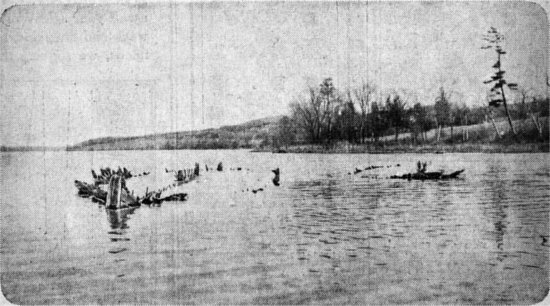Schooner Days CLVIII (208), 5 October 1935
Flame-lighted in Olivia’s Life-Log
By C.H.J. Snider

This long stretch of low water on the lakes, each summer bringing the level lower than the lowest of the preceding one, is as good as Gabriel's horn for resurrecting old ships and old memories.
About the time of the mariners' service in Cherry Valley the Schooner Days man wandered along the shores of Young's Cove in Picton. The water had all run away from the ornamental fish pond in the garden above. In the Cove itself, fresh cracked mud along the shoreline bespoke the continued ebb, and in the placid surface of the little bay two symmetrical ellipses showed like embossed patterns upon polished steel. They were the rungheads and floor-timbers of a pair of ancient wrecks, each bisected by a submerged keelson. Little forests of rusted bolts showed where centreboard boxes had stood and had decayed away.
The smaller wreck, obliging Pictonians said, was that of the Mary Gormally [(sic) In fact Mary Gormley. Ed.], a little schooner of which I had never heard. The larger wreck was that of the Olivia, about which I had heard a great deal; so much that I could not forbear paddling out in a punt to have a look at her remains.
Mooring to her sternpost, half-hollowed to take the round of the rudderstock, I let the little lisping waves tell her life story in pictures beginning 80 years back.
The first was painted in the wild red glare of the raw spring night of April 29th, 1853, with the steamer Ocean Wave in flames off the False Ducks. David Dulmage, South Bay farmer, was waked by the light through his bedroom window at 2 o'clock in the morning. He routed out his neighbors, and they rushed to Point Traverse, two miles away, through the frozen mud. They pushed off in a fish boat, and found a floating bonfire, wildly charging about, amid the screams of perishing passengers, till, having burned to the water's edge, it sank with a loud roar from its red-hot boilers. The flames had lighted the sails of two schooners which were picking up men and women struggling in the icy April waves. One of the vessels was the Georgina of Port Dover, Capt. Henderson. The other was the Emblem of Bronte, Capt. J. Belyea. And the Emblem, two years later, rebuilt and renamed, became the Olivia – "Oh leave yeh" the natives called her – long after kenned on the shores of Prince Edward, although Toronto was her port of hail, because it was there she had been registered after her first re-build.
One of the men Dulmage's boat picked up, struggling in the water, was Capt. Allison Wright of the late steamer Ocean Wave. The Emblem, or Olivia that was to be, rescued 19 survivors and took them to Kingston.
The Ocean Wave was a "through line" steamer, making a round trip a week between Hamilton and Montreal [Note: Ogdensdurg is more proabable. Ed.] She called at Helliwells Wharf here in Toronto, then at Whitby, Oshawa, "Port Darlington," (Bowmanville), "Bond Head" (Newcastle), Port Hope, Cobourg, Kingston, and the river towns. On this last trip she was reported to be carrying the company's earnings for the season – this seems strange, with the season just beginning – in gold and silver, for deposit in Montreal. The legend, losing nothing in the telling, has prompted more than one hopeful in Prince Edward County to prospect for her wreck and try to recover the fire-blistered safe.
Thirteen passengers and fifteen of the crew perished with the Ocean Wave, and the coroner's jury found that had a proper watch been maintained on board, the fire would not have made such swift and fatal progress. It started from sparks from the tall funnel. Like all the steamers of her time, the Ocean Wave was a cordwood burner. They always left a flame-trail on the night sky. There was talk that the Ocean Wave was firing extra hard to maintain steam while racing a rival liner. If so the rival was not near enough to see her plight or render assistance.
"The fire began in the engine room," said Capt. Wright, "and was discovered by the mate. We tried to run the ship ashore, but the fire was so great it drove the second mate from the wheel. In ten minutes all the lifeboats had been destroyed. The engines were still running, and the engineer couldn't get below to stop them. They were running when, wildly circling, she sank."
What made the fire uncontrollable was the presence of tons of tallow in the hold near the engine room. It flamed like a torch of incredible heat, and, melting, spread in flaming streams all over the lower deck. Many of the victims perished from these rivers of liquid fire.
Such was the Olivia's initiation upon the Prince Edward scene. Point Traverse, off which the Ocean Wave burned, is the extreme southeastern tip of the county. It was two years after the holocaust that the Emblem was rebuilt and registered in Toronto under the new name Olivia. She may have been a standing-keeler once, for it is noticeable in her wreckage, that the centreboard box had been built on one side of the keelson, the port one – usually the mark of a convert. Centreboards did not become general on the lakes before the 1850's.
The little waves painted several pictures of the Olivia's life in their innocent prattle, but perhaps this lurid beginning is enough for this time. Let us save the others for next week.
